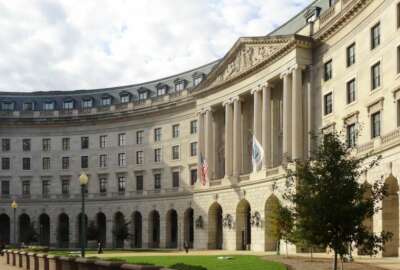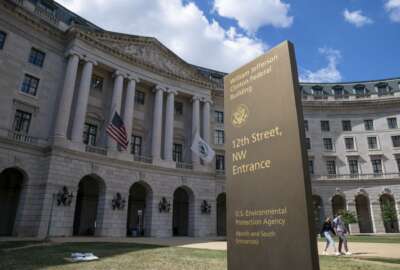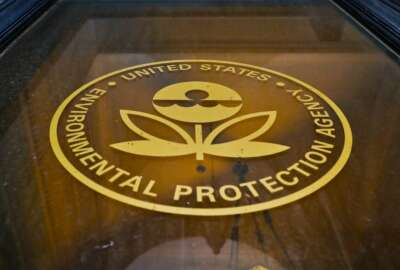
Telework will stay for some, as EPA preps social distancing plans for phase three reopening
In preparation for "phase three" of its reopening plans, regional leaders at the Environmental Protection Agency are developing social distancing and "cohort"...
As several agencies have brought small numbers of federal employees back to their offices during the first two stages of reopening, “phase three” — the point where the work environment was supposed to more closely resemble a sense of “normal” — has posed many unknowns.
The Environmental Protection Agency offered its employees a little more detail late last week on what that phase will look like.
EPA offices won’t necessarily experience a quick return to “normal,” with many employees still working from home or physically spaced out from their co-workers under new social distancing plans, the agency said in its phase three reopening guidance, which Federal News Network obtained.
“All EPA facilities are evaluated weekly using data from the Centers for Disease Control and Prevention and other expert sources,” James Hewitt, an agency spokesman, said in an email to Federal News Network. “This data is also reviewed by EPA scientific experts. These reviews, along with consideration of the status of the state and local reopenings, inform each decision. Any reopening will be phased in a measured and deliberate approach and transparent with all employees through our new dashboard service.”
EPA will wait at least two weeks before transitioning from phase two to three, the agency said. No EPA facilities have entered that transition period yet, as most regions are still in phase one of the agency’s reopening plan, Hewitt said.
Whenever an EPA facility does begin the phase three transition period, employees there will be expected to spend at least one day a week in the office.
“This requirement allows for an early opportunity to test social distancing plans, gather feedback and modify facility plans (e.g., elevator capacity), and allows employees to evaluate mass transit options,” the EPA guidance reads.
EPA regional and program leaders will place employees working in cubicles or enclosed shared working spaces into “cohorts,” which will follow specific schedules designed to observe social distancing procedures, the agency said.
Employees who work in their own private offices should return to their usual telework schedules. EPA managers will review social distancing and cohort schedules every eight weeks, or whenever guidance from the Centers for Disease Control and Prevention changes, the agency said.
For those working in EPA cubicles, employees are eligible for a minimum of five days of telework a pay period, the agency said. Employees will work with their supervisors to set their own remote and flexible work schedules.
Employees can come into the office between the hours of 5:30 a.m. and 9 p.m., which EPA said will “create a greater range of arrival and departure times to assist with elevator capacity concerns and commuting outside the normal rush hour.”
EPA employees who work in research laboratories will likely have different work schedules and flexibilities than their colleagues working in the agency’s offices.
“Conducting experiments, analyses and research may have many different time frames, as well as requirements for access to equipment and other resources that may not be conducive to structured, intermittent schedules,” EPA guidance reads.
Telework will remain available for employees with dependent care responsibilities, as will extended work hours, which allow employees to complete their duties between 5 a.m. and 11:30 p.m. Voluntary Saturday hours will also continue.
Employees who are high risk for the virus or have vulnerable family members living with them at home should also work with their supervisors to set a more flexible work schedule, the agency said.
EPA employees in these circumstances will review their work agreements with their supervisors every eight weeks, according to the EPA guidance.
Local agency leadership will also review mass transit options ahead of phase three reopening, EPA said. Depending on transit availability, the agency may offer more telework options.
Some employees have said they’re concerned with the agency’s early reentry plans, expressing some doubt that their own supervisors would grant them the flexibilities they say they need to continue working from home.
EPA’s phase three guidance may appear to relieve some of those worries, as the agency is allowing employees to simply self-certify their health concerns and dependent care responsibilities.
But the American Federation of Government Employees, which spent the last week bargaining with EPA over phase one and two reopening, said it received EPA’s phase three guidance on the evening before negotiations were supposed to conclude.
Read more Workforce news
Gary Morton, president of the AFGE council representing EPA employees, said the agency’s reopening plans were “overly ambitious” given the ongoing surge of coronavirus cases around the country.
“This so-called ‘guidance’ was issued during a week in which conditions for COVID-19 are so out of control nationwide that not a single one of EPA’s 126 locations meet the criteria for moving forward in the agency’s gating process,” he said in a July 18 letter to EPA Administrator Andrew Wheeler.
The agency and union have clashed since the early days of the pandemic. EPA has maintained that it’s kept the union informed of its plans throughout the health crisis. The agency launched a dashboard of public health data earlier this summer, which EPA said is guiding its reopening decisions for specific facilities.
All EPA employees have access to the facility dashboard. But union members have disputed the accuracy of the reopening criteria on the dashboard. They’re echoing a call AFGE made earlier this summer for a moratorium on reopening at EPA facilities.
“We stand by that call, which continues to be supported by science, and we demand that you put the brakes on the hasty, unsafe reopening of EPA offices,” Morton said.
Copyright © 2025 Federal News Network. All rights reserved. This website is not intended for users located within the European Economic Area.
Nicole Ogrysko is a reporter for Federal News Network focusing on the federal workforce and federal pay and benefits.
Follow @nogryskoWFED
Related Stories





